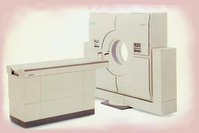Washington University PET scanner tracks cervical cancer

St. Louis, MO
A machine invented at Washington University to reveal the inner workings of brains and hearts is emerging as a premier tool for tracking cervical cancer.
The device, called a positron emission tomography (PET) scanner, is similar to MRI scanners but uses radioactivity instead of X-rays to create images of blood flowing through organs, brain activity and other processes.
New research from the Siteman Cancer Center at Barnes-Jewish Hospital and Washington University show that PET scans are more accurate than any other method at predicting the aggressiveness of a cervical cancer tumor. The device also effectively shows whether treatments had destroyed the cancer.
Previously, doctors had no way to determine whether radiation or other therapies were working until a patient experienced symptoms or another tumor was found.
"The look on (patients') faces, the happiness and the joy when you tell them, "It looks like you're going to do really well.' That's really powerful," said Dr. Julie K. Schwarz, a Barnes-Jewish Hospital resident in the Department of Radiation Oncology.
Schwarz was the lead author on one of the PET studies that was published last month in the Journal of the American Medical Association. Her research team studied women who had PET scans three months after completing radiation and chemotherapy between 2003 and 2006. The scans provided a more reliable measure of whether the cancer would recur, and, just as importantly, revealed whether the cancer was already beginning to return.
Each year, more than 10,000 women develop cervical cancer in the United States; about 3,900 die of the disease.
A key to turning PET scans into cancer-fighting tools was figuring out how to turn one property of cancer cells - their need for sugar to fuel growth - against them.
Now, researchers are trying to find out if the scans can do more than identify cancer cells quickly.
PET scans aren't used yet for every cancer patient, but they are proving to be effective at helping doctors decide whether to continue treatment. The scans already are used to detect spreading and recurrence of breast, ovarian, brain and other types of cancers.
"It has a big impact on preventing radical therapy that has no hope of curing the patient," said Dr. Barry Siegel, director of nuclear medicine at the Mallinckrodt Institute of Radiology at Washington University.
In some studies, researchers treated cancer patients with chemotherapy drugs, and within days, they were able to use PET scans to see whether the drug is working or a different type of treatment was needed.
The technology is complicated and expensive and requires highly specialized technicians to make the radioactive chemicals and administer the tests and well-trained doctors to interpret the results, said Dr. Elizabeth Swisher, a gynecological oncologist and associate professor at the University of Washington in Seattle. And, she added, the scans are not standardized.
"It's not the same to get a PET scan everywhere," Swisher said. "Just because it's an expensive test doesn't mean it's a good test."
Washington University is a leader in PET technology, Swisher said, adding that studies such as the one on Monroe will likely expand the use of PET in cancer treatment.
Monroe, who lives in south St. Louis County, had put off going to the doctor, even though she suspected that something was wrong. But after she was diagnosed with cervical cancer, she didn't put off treatment. She never missed a day.
The PET scan she had toward the end of her treatment showed that her tumor has shrunk significantly, Schwarz said. It's likely that the tumor will continue to shrink and disappear - a very promising prognosis. A follow-up PET scan three months after she completes chemotherapy will tell for sure.
"They told me (my PET scan) all looks good," Monroe said. "That's good enough for me. I'm happy with that."
Misread Pap Test failure to diagnose cervical cancer malpractice lawsuits
Labels: Cervical Cancer Prevention, Cervical Cancer Screening, Cervical Cancer Treatment






